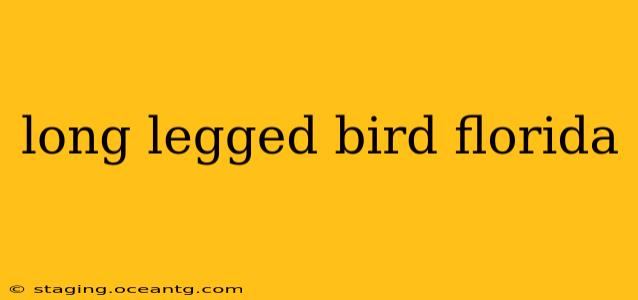Florida's diverse ecosystems, from its coastal wetlands to its pine flatwoods, support a remarkable array of bird species. Many of these birds share a striking feature: exceptionally long legs. These adaptations are crucial for wading in shallow waters, stalking prey in tall grasses, or simply navigating diverse terrains. This guide explores some of the most common long-legged birds found in the Sunshine State, examining their unique characteristics and habitats.
What are some long-legged birds found in Florida?
Several bird species in Florida boast notably long legs. Some of the most frequently sighted include:
-
Wading Birds: This group dominates the long-legged bird category in Florida. Think of iconic species like the Great Blue Heron, Great Egret, White Ibis, Wood Stork, and various species of herons and egrets. Their long legs allow them to wade effortlessly through shallow waters, searching for fish and other aquatic prey.
-
Shorebirds: Shorebirds, while often smaller than wading birds, also exhibit relatively long legs. These birds are typically found along Florida's extensive coastline and frequently visit beaches, mudflats, and salt marshes. Examples include the Sanderling, Willet, and various plovers.
-
Other Long-Legged Birds: Don't forget species like the Limpkin, a distinctive bird with long legs and a curved bill, and the various cranes (if you're lucky enough to spot them!).
What are the adaptations of long-legged birds in Florida?
The long legs of these birds are not merely for show; they provide several crucial adaptations for survival in their respective habitats:
-
Wading: The most obvious adaptation is the ability to wade in shallow water to forage for food. The length of their legs allows them to reach suitable depths without having to submerge their bodies.
-
Stalking Prey: Long legs provide a stealthy advantage when hunting. They allow birds to approach prey in tall grasses or shallow water without being easily detected.
-
Thermal Regulation: Long legs can help with thermoregulation, particularly in wading birds. Standing in shallow water allows heat to dissipate more efficiently, helping to cool the bird down.
-
Reaching Food Sources: Long legs are essential for accessing food sources that might be out of reach for birds with shorter legs.
How can I identify long-legged birds in Florida?
Identifying long-legged birds requires careful observation of several features beyond leg length:
-
Size and Shape: Pay attention to overall size and body shape. Herons are generally larger than egrets, and each species has its unique silhouette.
-
Plumage: Coloration and patterns are crucial identifiers. Note the color of the feathers, the presence of any distinctive markings, and any differences between male and female birds.
-
Bill Shape: The shape and size of the bill are often indicative of the bird's diet. Wading birds with long, spear-like bills often feed on fish, while those with shorter, more robust bills may prey on crustaceans or insects.
-
Behavior: Observe the bird's behavior, such as its foraging techniques, flight patterns, and social interactions.
Where are the best places to see long-legged birds in Florida?
Florida offers abundant opportunities for birdwatching. Some of the best locations for spotting long-legged birds include:
-
Everglades National Park: A haven for wading birds, offering a vast expanse of wetlands and diverse habitats.
-
** Merritt Island National Wildlife Refuge:** Another significant wetland area, providing important habitat for numerous wading bird species.
-
Various Coastal Areas: Florida's extensive coastline and estuaries are hotspots for shorebirds and other long-legged birds. Beaches, marshes, and mudflats provide excellent foraging grounds.
-
State Parks and Wildlife Management Areas: These protected areas offer diverse habitats and often provide excellent opportunities for birdwatching.
What is the best time of year to see long-legged birds in Florida?
The best time to see many long-legged birds in Florida is during their breeding and nesting seasons, which typically fall between spring and summer. However, many species remain year-round residents, so birdwatching opportunities are available throughout the year. Migration periods (spring and fall) often bring increased bird diversity.
This guide offers a starting point for learning about the fascinating world of long-legged birds in Florida. Remember that responsible birdwatching practices, including maintaining a safe distance and respecting their natural habitats, are crucial for ensuring their continued presence in the Sunshine State.
